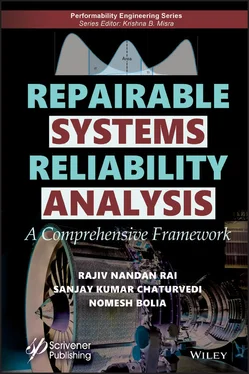1.1 Introduction
A system is a collection of mutually related items, assembled to perform one or more intended functions. Any system majorly consists of (i) items as the operating parts, (ii) attributes as the properties of items, and (iii) the link between items and attributes as interrelationships. A system is not only expected to perform its specified function(s) under its operating conditions and constraints but also expected to meet specified requirements, referred as performance and attributes. The system exhibits certain behavioural pattern that can never ever be exhibited by any of its constituent items or their subsets. The items of a system may themselves be systems, and every system may be part of a larger system in a hierarchy. Each system has a purpose for which items, attributes, and relationships have been organized. Everything else that remains outside the boundaries of system is considered as environment from where a system receives input (in the form of material, energy, and/or information) and makes output to the environment which might be in different form as that of the input it had received. Internally, the items communicate through input and output wherein output(s) of one items(s) becomes the input(s) to others. The inherent ability of an item/system to perform required function(s) with specified performance and attributes when it is utilized as specified is known as functionability [1]. This definition differentiates between the terms functionality and functionability where former is purely related to the function performed whereas latter also takes into considerations the level of performance achieved.
Despite the system is functionable at the beginning of its operational life, we are fully aware that even after using the perfect design, best technology available for its production or the materials from which it is made, certain irreversible changes are bound to occur due to the actions of various interacting and superimposing processes, such as corrosion, deformations, distortions, overheating, fatigue, or similar. These interacting processes are the main reason behind the change in the output characteristics of the system. The deviation of these characteristics from the specifications constitutes a failure . The failure of a system, therefore, can be defined as an event whose occurrence results in either loss of ability to perform required function(s) or loss of ability to satisfy the specified requirements (i.e., performance and/or attributes). Regardless of the reason of occurrence of this change, a failure causes system to transit from a state of functioning to a state of failure or state of unacceptable performance. For many systems, a transition to the unsatisfactory or failure state means retirement. Engineering systems of this type are known as non-maintained or non-reparable system because it is impossible to restore their functionability within reasonable time, means, and resources. For example, a missile is a non-repairable system once launched. Other examples of non-repairable systems include electric bulbs, batteries, transistors, etc. However, there are a large number of systems whose functionability can be restored by effecting certain specified tasks known as maintenance tasks . These tasks can be as complex as necessitating a complete overhaul or as simple as just cleaning, replacement, or adjustment. One can cite several examples of repairable systems one’s own day-to-day interactions with such systems that include but not limited to automobiles, computers, aircrafts, industrial machineries, etc. For instance, a laptop, not connected to an electrical power supply, may fail to start if its battery is dead. In this case, replacing the battery—a non-maintained item—with a new one may solve the problem. A television set is another example of a repairable system, which upon failure can be restored to satisfactory condition by simply replacing either the failed resistor or transistor or even a circuit board if that is the cause, or by adjusting the sweep or synchronization settings.
The system, in fact, wavers and stays between satisfactory and unsatisfactory states during its operational life until a decision is taken to dispense with it. The proportion of the time, during which the system is functionable, depends on the interaction between the inherent characteristics of a system from the design and utilization function given by the users’ specific requirements and actions. The prominent inherent characteristics could be reliability , maintainability , and supportability . Note that these characteristics are directly related to the frequency of failures, the complexity of a maintenance task, and ease to support that task. The utilization characteristics are driven by the users’ operational scenarios and maintenance policy adopted, which are further supported by the logistics functions, which is related to the provisioning of operational and maintenance resources needed. In short, the pattern followed by an engineering system can be termed as funtionability profile whose specific shape is governed by the inherent characteristics of design and system’s utilization. The metric Availability or its variants quantitatively summarize the functionability profile of an item/system. It is an extremely important and useful measure for reparable systems; besides, a technical aid in the cases where user is to make decisions regarding the acquisition of one item among several competing possibilities with differing values of reliability, maintainability, and supportability. Functionability and availability brought together indicates how good a system is. It is referred as system technical effectiveness representing the inherent capability of the system. Clearly, the biggest opportunity to make an impact on systems’ characteristics is at the design stage to won or lost the battle when changes and modifications are possible almost at negligible efforts. Therefore, the biggest challenge for engineers, scientists, and researchers has been to assess the impact of the design on the maintenance process at the earliest stage of the design through field experiences, analysis, planning and management. And, the repairable system analysis is not just constricted on finding out the reliability metrics.
Most complex systems, such as automobiles, communication systems, aircraft, engine controllers, printers, medical diagnostics systems, helicopters, train locomotives, and so on so forth are repaired once they fail. In fact, when a system enters into utilization process, it is exposed to three different performance influencing factors, viz. , operation, maintenance, and logistics, which should be strategically managed in accordance with the business plans of the owners. It is often of considerable interest to determine the reliability and other performance characteristics under these conditions. Areas of interest may include assessing the expected number of failures during the warranty period, maintaining a minimum reliability for an interval, addressing the rate of wear out, determining when to replace or overhaul a system, and minimizing its life cycle costs.
Traditional reliability life or accelerated test data analysis—nonpara-metric or parametric—is based on a truly random sample drawn from a single population and independent and identically distributed ( i.i.d. ) assumptions on the reliability data obtained from the testing/fielded units. This i.i.d. assumption may also be valid, intuitively, on the first failure of several identical units, coming from the same design and manufacturing process, fielded in a specified or assumed to be in an identical environment. Life data of such items usually consists of an item’s single failure (or very first failure for reparable items) times with some items may be still surviving-referred as censoring or suspension. The reliability literature is in plenty to cover such aspects in reliability data analysis where the failure times are modeled by appropriate life distributions [2].
Читать дальше












